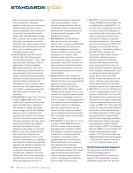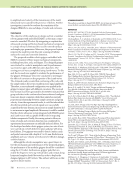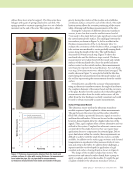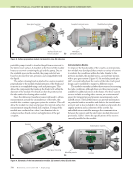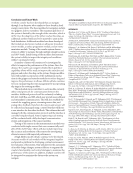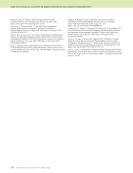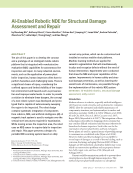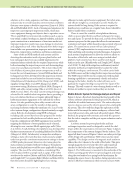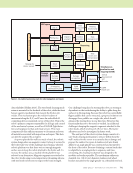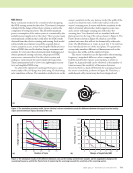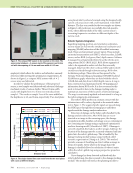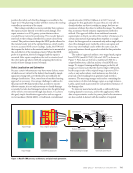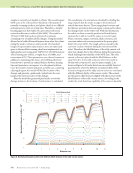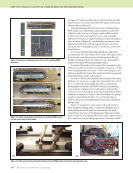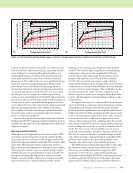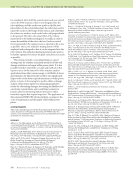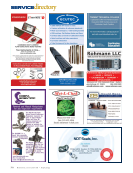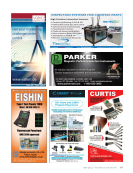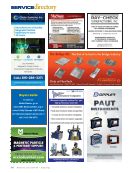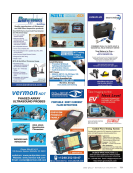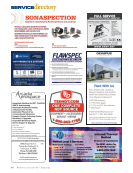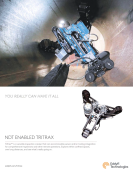686 M A T E R I A L S E V A L U A T I O N • J U L Y 2 0 2 1 robot and composite structure. Positional coordinates were established with the first composite structure and used to offset the robot base frame attached to the robot path plan for subsequent composite structures. During testing of the LPS’s performance, the large composite structure was moved approximately 150 mm in the X direction to represent a subsequent structure. After shooting the targets and updating the base frame of the existing robot path plan, the robot start position was corrected to within 2 mm on the representative subsequent composite structure. Conclusion Automated robotic systems offer significant versatility and flexibility for NDT applications. The inspection of a large variety of aerospace parts can be accommodated with different NDT tools, which are quickly swapped on and off the robot. It would be difficult to perform the NDT of a fuselage structure or an engine cowl with a traditional gantry system without designing the system specific to the part structure. In this paper, a system approach was provided with design principles to tailor the robot for C-scan output, irrespective of the specific part structure. These principles include keeping the TCP normal to the part surface during inspection, using linear arrays for electronic scanning, keeping a constant skew angle during inspection, and creating instrument sampling resolution relative to the TCP movement. Although examples of linear arrays were discussed, NDT methods and techniques such as laser UT or IR could also be used. System module testing was demonstrated to verify C-scan coverage, C-scan pixel alignment, and alignment of robot path plan to part placement. In this manner, the automated robotic system is proving to be versatile, scalable, and flexible. Since the use of automated robotic systems in the NDT technology domain is now in its infancy, there is a huge potential for advancement and growth. w ACKNOWLEDGMENTS The author would like to acknowledge the contributions to this paper and the technologies herein by Mike Bloom, Christopher Brown, Hien Bui, Justin Serrill, Kareem Shehab, Hong Tat, and Jim Troy. AUTHOR Barry A. Fetzer: The Boeing Co., Renton, WA barry.a.fetzer@boeing.com CITATION Materials Evaluation 79 (7): 678–686 https://doi.org/10.32548/2021.me-04224 ©2021 American Society for Nondestructive Testing REFERENCES Brekow, G., H.-J. Montag, R. Boehm, D. Brackrock, and J. Kitze, 2014, “Ultrasonic Testing Using Matrix Arrays for Discontinuity Detection,” Materials Evaluation, Vol. 72, No. 9, pp. 1131–1136 Craig, J., 2004, Introduction to Robotics: Mechanics and Control, 3rd ed., Prentice Hall Fetzer, B., J. Serrill, and K. Shehab, 2019, Automated Ultra- sonic Inspection of Elongated Composite Members Using Single-Pass Robotic System, US Patent 20200393418, filed 11 June 2019, and issued 17 December 2020 Fetzer, B., C. Brown, K. Bray, M. Duncan, and S. Walton, 2014, Non-Destructive Ultrasonic Inspection Apparatus, Systems, and Methods, US Patent 9,664,652, filed 30 October 2014, and issued 30 May 2017 Munikoti, V., M. Pohl, D. Sabrautzki, and D. Tscharntke, 2012, “Discontinuity Rating Using Distance Gain Size Tech- nique for Phased Array Ultrasonic Testing,” Materials Evalu- ation, Vol. 70, No. 12, pp. 1365–1371 Olympus, 2004, “Introduction to Phased Array Ultrasonic Technology Applications,” available at https://www.olympus-ims.com/en/books/pa/pa-intro Tat, H., W. Tapia, B. Fetzer, G. Georgeson, M. Freet, and J. Thompson, 2017, Thermography Inspection for Near- Surface Inconsistencies of Composite Structures, US Patent 10,677,715, filed 22 November 2017, and issued 9 June 2020 Troy, J., B. Fetzer, S. Lea, and G. Georgeson, 2015, Location Calibration for Automated Production Manufacturing, US Patent 9,740,191, filed 12 February 2015, and issued 22 August 2017 Tumsys, O., and E. Jasiuniene, 2014, “The Focusing of the Ultrasonic Phased Array in the Case of Non-Contact NDT Methods,” Electronic Measurements, Vol. 20, No. 3, pp. 44–47, https://doi.org/10.5755/j01.eee.20.3.3638 ME FEATURE w automated robotic systems for aerospace ndt
A erial robotic systems, also referred to as drones, enable the collec- tion of data on a scale and scope heretofore unimaginable. Field inspections at industrial sites using an aerial robotic inspection system that makes physical contact with a structure or asset as part of a nondestructive testing (NDT) or nondestructive evaluation (NDE) routine is safer than placing humans at elevation and enables more data to be gathered in less time. These aerial robotic systems are highly extensible and agile enabling safer, faster, and better inspections. Robotic inspection systems are forecast to grow exponentially this decade and beyond, as asset owners and service providers realize their economic value creation, increased data collection, and safety contributions. One early use case of these aerial robotic systems measures wall thickness (in other words, the thickness of a substrate) with a handheld electronic ultrasonic testing (UT) measurement device (see Figure 1). Selected and implemented properly, these systems positively impact safety, time, analytics, access, and cost. Aerial Robots for Contact-Based Ultrasonic Thickness Measurements for Field Inspections by Robert (Bob) Dahlstrom UTdrones J U L Y 2 0 2 1 • M A T E R I A L S E V A L U A T I O N 687 w ME FEATURE
ASNT grants non-exclusive, non-transferable license of this material to . All rights reserved. © ASNT 2025. To report unauthorized use, contact: customersupport@asnt.org



























































